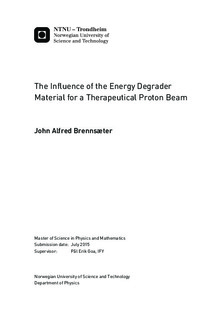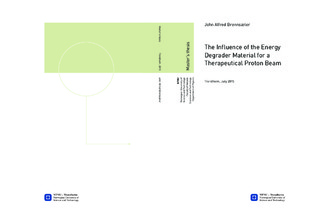| dc.description.abstract | In cyclotron based proton therapy an energy degrader is needed to modulate the proton beam energy. The proton beam energy decides the range of the particles and thereby where the dose is imparted. The influence of the material of the energy degrader for a 250 MeV therapeutic proton beam has been evaluated with FLUKA, a Monte Carlo based particle transport software. A geometry of a double wedge degrader of beryllium, carbon or lexan and a collimator of copper and carbon has been used. The momentum spread, angular spread, transmission fraction neutron yield and photon yield have been measured. The results show that the momentum spread is unaffected of the degrader material. The momentum spread affects the transmission fraction as the maximum momentum spread has to be limited by a momentum slit after the degrader. In the next round this also leads to that the distal dose fall off in a compact proton therapy facility without a momentum analyzer is unaffected by the degrader material. Further, the results have shown that beryllium gives a lower angular spread than the other materials. The transmission fraction through the degrader and collimator is around 2\% for all degrader materials at 70 MeV. Due to the reduced angular spread a beryllium degrader may increase the transmission fraction with as much as 43\% for short range degraded proton beams compared to a carbon degrader. Beryllium has also shown to generate the highest amount of neutrons. For a 70 MeV proton beam, the neutron yield is increased with 50\% compared to a carbon degrader, and with 82\% compared to a lexan degrader. This leads to extended harmful neutron radiation that increases the need for neutron shielding around the degrader. This makes beryllium a less attractive degrader material for a compact proton therapy facility, as the degrader then is located close to the treatment room. | |

